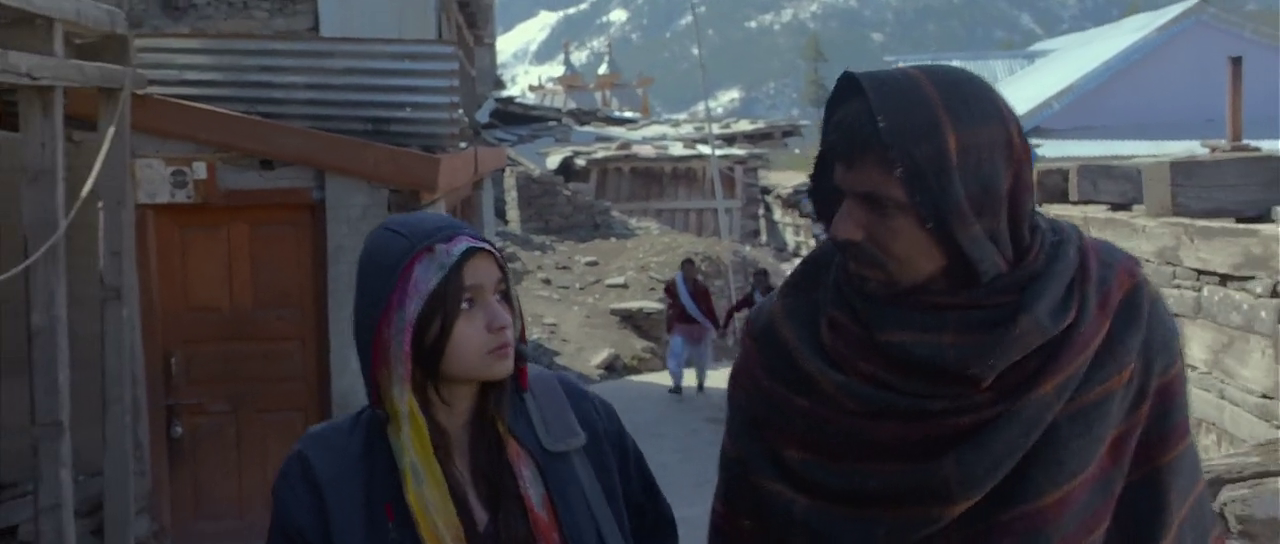Reimagining: Part 3
To feel the wind
run across your cheeks, shout out your joys to the world and wail out your woes
to the heart’s content, these are the little joys of freedom that we keep
seeking. But any individual’s right to these freedoms remain hidden away, under
many layers of social, political and other reasons. Madhumanti, through her
article on Highway, creates an enigmatic realm of words, and takes us on a
journey towards freedom, reveals the costs and rewards of achieving this
freedom and in the process remind us for a final time in this series that
Bollywood speaks to us of life itself through its screens. The curtains fall
with the story of victory and the celebration of life and freedom through
Bollywood.
Highway: A Rendezvous with Life
From
black-and-white to digital print, from hindi to hinglish lyrics, from coyness
to bold depiction of sex- Bollywood has come a long way. It has given birth to
new stereotypes, broken the old ones, and, in doing so, reshaped the landscape.
Now what does ‘landscape’ signify in films? In Martin Lefebvre’s words,
landscape in film is a ‘space of aesthetic contemplation and spectacle.’
(Lefebvre xviii). It is distinct from the ‘setting’ where the action unfolds
itself. Firstly, it is a form of view (spectacle) and then it vests a spatial
object with meanings and representations, extending from every sphere of real
life- culture, society, politics, economy, language and so on. Bollywood- the
Indian film industry, with its more than hundred years’ legacy, thus, shapes
and reshapes, imagines and reimagines the taste of the rapidly changing
multi-cultural Indian society across caste ,creed, conventions and gender. It
tells tales of personal agony, public shame, national crisis, global concern of
people through the popular genres of romance and tragedies. Like any other form
of art, every Indian at times identifies himself with the on-goings in the
silver screen, at times distances himself from the dreamy world of fantasy.
However, they can’t be indifferent to this mesmerizing form of audio-visual
art. It is possible as the ‘landscape’
induces certain emotions in the audience and allows them a certain freedom or
autonomy from the narrative. Having this license of autonomy, this essay
attempts to elucidate the concept of ‘reimagining landscape’ through an
unconventional Bollywood film of recent time, Highway (2014).
Highway
does not strictly conform to the genre of romances or tragedies, though, it
comprises the elements of both. It is a road movie which blurs the distinction
of physical and emotional landscape. It falls in that fuzzy zone where nature
engages itself in a conversation with culture, love triumphs over class-hatred,
hunter becomes liberator and journey becomes life. It can be described as a
tale of two grown-ups with the scars of childhood, hidden carefully in the
attics of their heart, and coming to terms with it. The film portrays two
different perspectives- One who shuns the comfort of home to embrace the road ,as,
home was always been a source of terror, horror and oppression to her; On the
other, one who earnestly wants to go back home, where his mother’s lap beckons him. Barring the
class-caste-gender barriers, can the two people be called the protagonists of
this movie? Or is it the highway, where they two met? The highway where Veera
tastes freedom for the first time and Mahabir chooses his destiny.
The film starts with snaps and shots of
wedding preparations, going in full swing, at a rich household. The bride, in
the darkness of the night, stealthily unlocks the gate and goes for a drive
with her fiancé`. Despite the beau’s reluctance, Veera the heroine insists him on
taking the highway and they halt at an empty gas station. And here, the doom
falls. A gang of dacoits kidnaps Veera and takes her away. Later, the dacoits
are divided into opinions when they come to know that Veera is a daughter of the
influential business tycoon Manik Tripathi. Without paying any heed to the
imminent danger, Mahabir, the rough-rustic-ruffian sets out for hiding along
with Veera. She was a ‘token’, a ‘sauda’ when the journey starts. She
becomes the solace, probably a reflection of that ‘mother-figure’, he misses
each moment, at the end of his journey- physical as well as personal. Veera represents
that class which Mahabir abhors and he is bent on selling her at some ‘kotha’.
But she becomes a classless face of humanity on whose arms he breaths his last.
Thus the class-gender politics is interwoven in this movie and it shapes the
emotional landscape of the characters as well.
The emotions Veera feels for Mahabir, can it
be called love or friendship or something else? Veera herself has not answerd
this:
Shadi
bhi nehi karni , bacche bhi nehi pal ni, bas thodi der aur tumhare sath ….
maine aisa pehele feel nehi kiya na……
Though she
admits, it is selfishness on her part, as her wish lands Mahabir into troubles,
this relationship defies name. As Veera shuns the comfort of her elite society,
the conventions and decorum of ‘well-behaved’ upbringing, this relationship is
one of those kinds which defy lok laj ke
soch. On the other hand, it is love
on Mahabir’s part. Those wistful starings at Veera unshackle the stone-hearted
Mahabir from the hatred. He knows his
end lurking somewhere near. He knows he can’t sell her to any ‘kotha’ anymore.
And hence, he runs away from Veera, from the fear of getting attached with her.
But they are destined to meet and the journey continues.
To look and to see…
The journey stretches from the Delhi Highway
to the rusty terrains of the city’s outskirt, from Ajmer to the salty patches
of Rajasthan, from dark abandoned store-houses to the snowcapped hills of
Himachal and Kashmir. For Veera, the vast stretches of sand and the all
encompassing sky are the most secure places on earth. She can do whatever she
wants to do and Mahabir is there for her. She climbs up the tree; gets her hair
washed in the road side tap, her toes touch the corn saplings. It was
once-in-a-lifetime-experience for her, as, she always feels claustrophobic in
the showy world of glitz, glamour and affluence. She gets her wish fulfilled having
a house on the top of the mountain which she always dreamt to have. She cooks
food, sweeps the floor, serves the food and probably had a peaceful sleep in
the strong arms of Mahabir. The huge physical landscape, that depicts the
Indian geography in its whites and blacks, comprising dark alleys to long and
wide highways, is not only a journey from place to place, but a heart to
another heart, a mind to another mind. It is a to-and-fro journey within and
without; the ‘inside’ becomes the ‘outside’; the ‘outside’ heals the ‘inside’;
In Veera’s words:
Tum
jaha se laye ho, waha mein wapas nehi janha chaha ti, tum jaha le ja rahe ho
waha pouch na nehi chahti, bas ye raasta bohat accha hai.
When we find the wind
beneath our wings
Highway
is an exploration of self for one; an excavation of those untrodden recesses of
mind as well as an excursion to nature, for both. Veera’s world is
pre-dominated by the overwhelming question of “kaha hoon main”, “kyon hai ye
sab’’. Not delving much into the ontological question, it can be said man
explores nature and this interaction strengthens his inner being. Taking a cue
from the English poet Wordsworth’s pantheism, the man-nature-god trinity is
hinted at in Veera’s self-discovery. Though the motif of spiritual quest is not
explicit, the Sufi song ‘tu kuja’ creates the ambience, where the one longs for
the supreme One. Again, the emotional landscape has been etched out by the
geographical space they inhabit. Mahabir’s rustic upbringing makes him strong
and sturdy at a very early stage of life. But Veera musters the courage to
confront her oppressor soon returning from this journey.
Veera returned back, Mahabir could not. She
came back home only to leave it with renewed spirit and zest. She confronted,
weeped, broke down and renounced the sham world of mannerism, hypocrisy, and
falsehood. She went back to the hills, got engaged in some productive work and
missed Mahabir.
Having seen many
aspects of the movie from different perspectives, I find the movie in the
psychoanalytical light of a retreat to the childhood days; the days which every
grown-up person loves to cherish, relish as well as nourish in the hustle of
busy days afterwards. For Mahabir, it was a sure call as he always condemns
himself for stenching his hands with human blood. As he kept on humming the
tune of his mother, his sobbing in the arms of Veera taking the name of ‘amma
amma’ are indicators. The final scene confirms this idea. Veera visualizes. A girl from a millionaire house, a boy from the lowest stratum of the society, a girl from an urban world, a boy
from the countryside, a girl who never seen poverty, a boy who was always aware
of the class-exploitation, sitting together facing the sky. This scene is a telling
one. And it confirms my view of a psychosexual retreat to the childhood days.
The
lush green valleys welcome you home
The question which I raised earlier seems to
find an answer at the end of this essay. The protagonist of this movie is none
other than the landscape- geographical, cultural and most importantly
emotional. The vast stretches of unadorned nature is not only a source of
delight for a rich lad who always stays in hotels on vacation, but also a
journey to the contours of India. The language, in which Mahabir speaks, is
symptomatic of Indian rustic-hariyanvi-context of petty criminals.
Landscape in every Bollywood movie is
multi-faceted, multi-layered as well as multi-dimensional. It is open-ended,
providing the audience with the choice to hold on to or leave aside. Highway, as a movie, has some technical
shortcomings, vagueness of meaning at places. But the movie opens up a plethora
of stimulating discussions- the physical, cultural, political, social as well
as emotional treasures of landscape on which the movie-buffs love to walk miles
after miles and the journey continues.
And the journey
continues…
Picture Sources: Images
taken from the movie
Author’s
Bio-Note:
Madhumanti has completed her masters in
English from Presidency University. She is a Bollywood enthusiast and social
networking savvy.








No comments:
Post a Comment